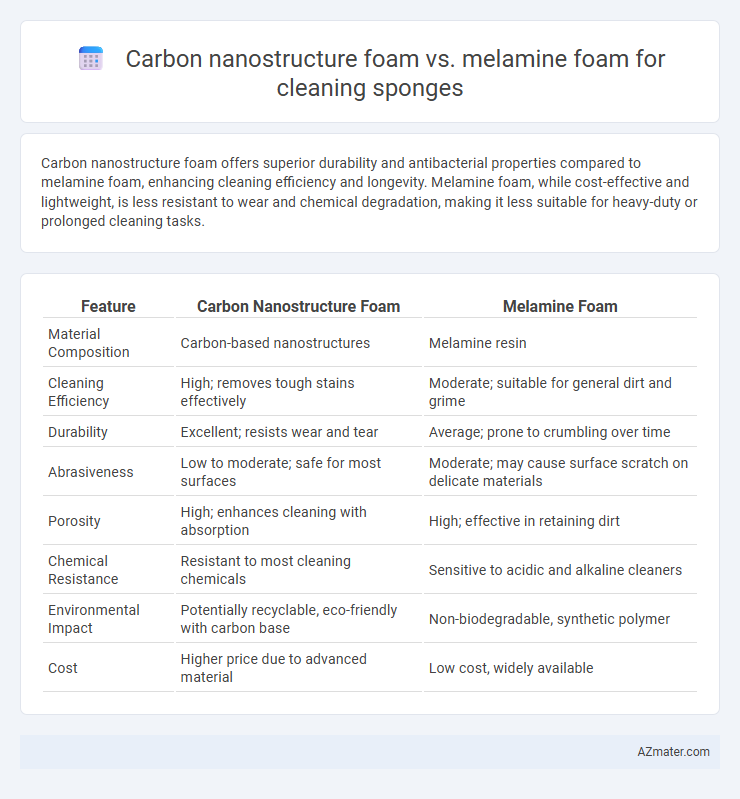Carbon nanostructure foam offers superior durability and antibacterial properties compared to melamine foam, enhancing cleaning efficiency and longevity. Melamine foam, while cost-effective and lightweight, is less resistant to wear and chemical degradation, making it less suitable for heavy-duty or prolonged cleaning tasks.
Table of Comparison
| Feature | Carbon Nanostructure Foam | Melamine Foam |
|---|---|---|
| Material Composition | Carbon-based nanostructures | Melamine resin |
| Cleaning Efficiency | High; removes tough stains effectively | Moderate; suitable for general dirt and grime |
| Durability | Excellent; resists wear and tear | Average; prone to crumbling over time |
| Abrasiveness | Low to moderate; safe for most surfaces | Moderate; may cause surface scratch on delicate materials |
| Porosity | High; enhances cleaning with absorption | High; effective in retaining dirt |
| Chemical Resistance | Resistant to most cleaning chemicals | Sensitive to acidic and alkaline cleaners |
| Environmental Impact | Potentially recyclable, eco-friendly with carbon base | Non-biodegradable, synthetic polymer |
| Cost | Higher price due to advanced material | Low cost, widely available |
Introduction to Advanced Cleaning Sponges
Carbon nanostructure foam offers superior durability, exceptional stain resistance, and high thermal stability, making it ideal for advanced cleaning applications compared to melamine foam. Melamine foam is widely recognized for its microstructure that enables effective dirt and grime removal at a microscopic level but tends to degrade faster with heavy use. The innovative properties of carbon nanostructure foam provide enhanced cleaning efficiency and longevity, positioning it as a cutting-edge material for next-generation cleaning sponges.
What are Carbon Nanostructure Foams?
Carbon nanostructure foams are advanced porous materials composed of interconnected networks of carbon nanotubes or graphene, offering exceptional mechanical strength and high surface area. These foams exhibit superior adsorption capabilities and durability compared to melamine foams, making them highly effective for cleaning applications requiring deep dirt removal and resistance to wear. The unique nanoscale architecture of carbon nanostructure foams enables enhanced chemical resistance and reusability, outperforming traditional melamine sponges.
Understanding Melamine Foam Properties
Melamine foam offers exceptional cleaning efficiency due to its open-cell structure and micro-porous network, enabling it to physically remove dirt and stains without chemicals. Its lightweight, high abrasion resistance, and thermal stability make it ideal for delicate surfaces and household cleaning tasks. Compared to carbon nanostructure foam, melamine foam excels in versatility and cost-effectiveness while maintaining strong absorbency and resilience.
Cleaning Efficiency: Carbon Nanostructure vs Melamine Foam
Carbon nanostructure foam exhibits superior cleaning efficiency compared to melamine foam due to its enhanced surface area and hydrophobic properties, enabling more effective dirt and oil absorption. The nanostructured carbon framework provides higher mechanical strength and durability, ensuring longer-lasting performance under rigorous cleaning conditions. In contrast, melamine foam relies primarily on microstructure abrasiveness but lacks the chemical affinity and robustness of carbon nanostructure foams, resulting in faster wear and reduced efficacy on stubborn stains.
Durability and Longevity Comparison
Carbon nanostructure foam exhibits superior durability and longevity compared to melamine foam due to its robust molecular framework and resistance to wear. Its high tensile strength and thermal stability enable sustained cleaning performance under harsh conditions, reducing the frequency of replacement. Melamine foam, while effective for light cleaning, degrades faster with repeated use and exposure to chemicals, resulting in shorter lifespan.
Environmental Impact and Sustainability
Carbon nanostructure foam exhibits superior environmental benefits compared to traditional melamine foam due to its higher durability and reusability, which reduces waste generation significantly. Its production involves fewer toxic chemicals and lower energy consumption, enhancing overall sustainability metrics and lowering carbon footprint. Melamine foam, while effective, often degrades quickly and contributes to microplastic pollution, making it less eco-friendly in long-term applications.
Safety and Chemical Considerations
Carbon nanostructure foam exhibits superior chemical resistance and thermal stability compared to melamine foam, making it safer for use with harsh cleaning agents and high-temperature applications. Melamine foam, while effective for light abrasive cleaning, can degrade or release potentially harmful compounds when exposed to strong acids or alkalis. From a safety perspective, carbon nanostructure foam minimizes risks related to chemical degradation and toxic exposure, offering greater durability and user protection during intensive cleaning tasks.
Cost-Effectiveness Analysis
Carbon nanostructure foam demonstrates higher durability and superior cleaning efficiency compared to melamine foam, resulting in longer lifespan and reduced replacement frequency. Although the initial cost of carbon nanostructure foam is higher, its enhanced performance and reusability provide better cost-effectiveness over time. Melamine foam, while cheaper upfront, tends to wear out faster and requires more frequent replacement, increasing long-term expenses.
Applications and Use Cases
Carbon nanostructure foam demonstrates superior durability and chemical resistance compared to melamine foam, making it ideal for heavy-duty industrial cleaning applications involving oil, grease, and chemical spills. Melamine foam excels in household cleaning tasks due to its excellent abrasive properties that effectively remove stains and dirt from surfaces like walls, floors, and kitchenware without the need for harsh chemicals. Both materials serve distinct use cases, with carbon nanostructure foam favored in environments requiring long-term performance and resistance to harsh substances, while melamine foam is preferred for routine, gentle cleaning in residential settings.
Which Cleaning Sponge Is Best for You?
Carbon nanostructure foam offers superior durability, excellent thermal resistance, and higher adsorption capacity for tough cleaning tasks, making it ideal for heavy-duty applications and environmentally conscious users. Melamine foam is lightweight, cost-effective, and highly efficient for removing stains and grime from delicate surfaces, suitable for everyday household cleaning. Choosing the best cleaning sponge depends on your specific cleaning needs--select carbon nanostructure foam for robust performance and longevity or melamine foam for gentle, effective surface cleaning.

Infographic: Carbon nanostructure foam vs Melamine foam for Cleaning sponge
 azmater.com
azmater.com